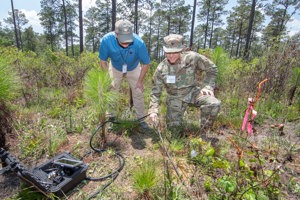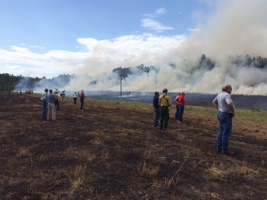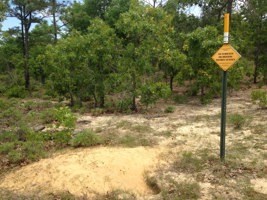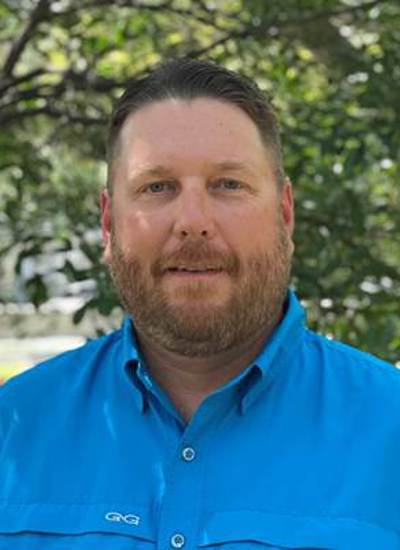- Home >
- Strategic Plan and Focus Areas >
- At-Risk, Threatened, and Endangered Species
At-Risk, Threatened, and Endangered Species



About
Military installations provide habitat for significant populations of federally listed and at-risk species. Meeting the requirements of the Endangered Species Act (ESA) can and does impact training and testing on military installations. At-Risk species are defined as those species that have been proposed for listing* by the U.S. Fish and Wildlife Service (Service), designated as candidate species by the Service or which the Service has been petitioned to list under the ESA, or rare species.
The SERPPAS At-Risk, Threatened and Endangered Species Work Group collaborates with federal, state, and other partners to develop and promote innovative strategies for proactive conservation of at-risk species and increased flexibility for addressing impacts to both listed species and military missions. These approaches include conservation agreements, mitigation credit strategies, and projects to increase status information of at-risk species to inform Service listing decisions and to support partner efforts for the overall conservation and recovery of these species.
These efforts will promote and support ecosystem restoration, maintenance, and monitoring on and off military installations to enhance the conservation of at-risk and listed species; increase flexibility for on-installation training and testing; increase regulatory predictability for military services, other federal and state agencies, and private landowners who engage in proactive conservation.
*Proposed for listing means the Service has proposed a draft rule in the Federal Register to list the species as threatened or endangered under the ESA; however, a final listing decision has not been made.
Strategic Objectives
- Identify focus species and funding opportunities to promote implementation of programs that conserve, manage, and support recovery of listed species and provide direct benefits to military installations (both on and off installations) and SERPPAS partners. This could include but is not limited to habitat and multi-species crediting strategies.
- Identify opportunities to proactively conserve at-risk species populations or habitat that are important to SERPPAS in a manner that would preclude the need to list a species, through conservation agreements and other approaches.
- Use existing geospatial information, such as the SERPPAS good map and SECAS layer, to enhance, improve and/or make functional corridors for wildlife with an eye to climate resilience, and to enhance and support larger conservation goals and Sentinel Landscapes.
Work Group Lead

Dr. Rebecca Harrison (Lead)
At-Risk Species CoordinatorU.S. Fish and Wildlife Service
470-925-5310| rebecca_harrison@fws.gov
Becky Harrison is the at-risk species coordinator for the Southeast region with the U.S. Fish and Wildlife Service. She has 25 years of experience in species conservation and adaptative management and has worked within diverse partner groups to create unified frameworks for strategic conservation planning and delivery.
She has degrees in Zoology and Wildlife Biology from Michigan State University (B.Sc.), Utah State University (M.Sc.) and North Carolina State University (PhD). Her post-doctoral work at University of Georgia was supported through a fellowship at the National Institutes of Health. This research used the monarch butterfly as a model system of migration to investigate how animal movement patterns are influenced by infectious disease.
Becky joined the U.S. Fish and Wildlife Service in 2011 and has worked across programs including the South Atlantic Inventory & Monitoring Network, the National Wildlife Refuge System, Ecological Services, and Partners in Flight on collaborative conservation management projects across taxa including pollinators, red wolves, sea turtles, and migratory birds. She also serves as the species recovery lead for the endangered St. Francis satyr butterfly at Fort Bragg. She has collaborated with U.S. Army personnel, natural resource managers, and researchers on conservation management issues there since 2003. Her commitment to negotiating critical resource management decisions has recognized with several awards including the Secretary of the Interior’s Commendation award in 2017.

Lucas Cooksey (Co-Lead)
Project DirectorTexas A&M Natural Resources Institute
lucas.cooksey@ag.tamu.edu
Lucas Cooksey is a project director for the Texas A&M Natural Resources Institute, blending policy, planning, and practice into seamless programs that both sustain and enhance active land use alongside meaningful natural resource conservation.
With more than 20 years of experience in Natural Resources Management, his career includes appointments as a Park Ranger with the U.S. Army Corps of Engineers, serving as the U.S. Army Fort Sam Houston & U.S. Air Force Joint Base San Antonio – Natural Resource Program Manager, the Senior Natural Resource Specialist for the U.S. Army Environmental Command, and the Natural Resources Program Manager for the U.S. Army Installation Management Command Headquarters, where he lead the conservation programs on over 75 Army Installations throughout the U.S and abroad.
His development of innovative projects that balance ecosystem management and military readiness have been recognized by receiving the Texas Parks & Wildlife “Lonestar Land Steward Award” in 2010 and the Secretary of the Army “Civilian Service Commendation Medal” in 2020.
Lucas attended Texas A&M University-Kingsville receiving a Bachelor’s Degree in Range and Wildlife Management and then obtained a Master’s Degree in Biology from Texas State University-San Marcos.
Request to Join Work Group
Resources
Documents
Websites
DoD Natural Resources Program
America's Longleaf Restoration Initiative
Southeastern Association of Fish and Wildlife Agencies (SEAFWA)
USFWS Southeast's At-Risk Species Finder
Integrated Natural Resources Management Plan (INRMP) Repository
SERPPAS ARTE Work Group Focal Species List - This list has been compiled by the SERPPAS At-risk, Threatened and Endangered Species work group. It is intended to help partners understand and identify possible overlapping at-risk species priorities in the SERPPAS region. This list is purely informational and does not inherently indicate action.
News

NFWF Announces Record $33.5 Million in Conservation Grants to Restore Longleaf Pine Habitat and Help At-Risk Wildlife
7/18/24
The National Fish and Wildlife Foundation announced $33.5 million in conservation grants from the Longleaf Landscape Stewardship Fund to restore, enhance, and protect longleaf pine forests in eight southern states. This year’s grant slate is the largest in the program’s history, building on a recent trend of increased funding for longleaf pine restoration. These grants will leverage $21.2 million in matching contributions to generate a total conservation impact of $54.7 million. These funded projects each help to advance the restoration goals of America’s Longleaf Restoration Initiative laid out in the Range-wide Conservation Plan (2025-2040).
Visit the SERPPAS News Archive
ALRI Looks to the Future and Celebrates the Past with 2023 Achievements
7/11/24
The 2023 America’s Longleaf Restoration Initiative Range-wide Accomplishment Report is now available. The 2023 report celebrates over 2.17 million acres of accomplishments on longleaf lands as well as ALRI’s initial 15 years of partnership.
Visit the SERPPAS News Archive
For the love of salt marshes: Michelle Covi fights for coastal resiliency
6/11/24
SERPPAS Coastal Resilience and Regional Adaptation work group lead Dr. Michelle Covi was featured in an article from UGA Research about her work as the Department of Defense’s coastal resiliency liaison through UGA Marine Extension and Georgia Sea Grant.
Visit the SERPPAS News Archive
Announcing 2024 Sentinel Landscapes to Address Climate Change Impacts and Strengthen Military Readiness
5/15/24
The Sentinel Landscapes Partnership, comprised of the U.S. Department of Agriculture (USDA), Department of Defense (DOD), and Department of the Interior (DOI), announced the designation of five new sentinel landscapes. In these landscapes, natural and working lands thrive alongside military installations and ranges. The partnership is excited to welcome these new landscapes and support their partners' work to mitigate climate change impacts and improve sustainable land and water management practices around military installations.
Visit the SERPPAS News Archive
DOD and Department of the Interior Renew Partnership for Conserving Wildlife and Supporting Military Readiness
5/15/24
Leaders from the Department of Defense and the Department of the Interior met at the Pentagon in May to celebrate the renewal of the Recovery and Sustainment Partnership (RASP) following the signing of a Memorandum of Understanding earlier this year designed to advance the recovery of threatened and endangered species while also supporting national security.
Visit the SERPPAS News Archive
REPI Program Releases the REPI Challenge FY 2025 Request for Proposals
5/6/24
DOD's REPI Program is pleased to announce the release of the REPI Challenge Fiscal Year (FY) 2025 Request for Proposals (RFP). The REPI Program designed the REPI Challenge to help meet its ambitious conservation goals while aiming to cultivate new projects, harness creativity, and protect critical testing and training capabilities.
Visit the SERPPAS News Archive





Events & Webinars
- Acoustic Surveys for Bats: Detector Placement, Call Analysis, and Interpretation
-
July 30, 2024
Webinar (hosted by DoD) - Wildlife Movement in Solar Facilities in North Carolina
-
August 29, 2024
Webinar (hosted by REWI) - 7th Annual National Cohesive Wildland Fire Management Strategy Workshop
-
September 16 - 19, 2024
Atlantic City, NJ - 2024 Society of American Foresters National Convention
-
September 17 - 20, 2024
Loveland, CO - Fire Weather Portal for the Southeast
-
September 24, 2024
Webinar (hosted by NOAA) - RAE 2024 Coastal & Estuarine Summit
-
October 6 - 10, 2024
- 15th Biennial Longleaf Conference
-
October 8 - 11, 2024
Sandestin, FL - AICUZ and REPI Partnerships for Enhanced Land Protection
-
October 9, 2024
Webinar (hosted by REPI) - 78th Annual SEAFWA Conference
-
October 12 - 16, 2024
Augusta, GA - Navigating Military Readiness Through Responsible Project Execution
-
December 11, 2024
Webinar (hosted by REPI)
SERPPAS Meetings
- Fall 2024 Steering Committee Meeting
-
September 10 - 11, 2024
Atlanta, GA




